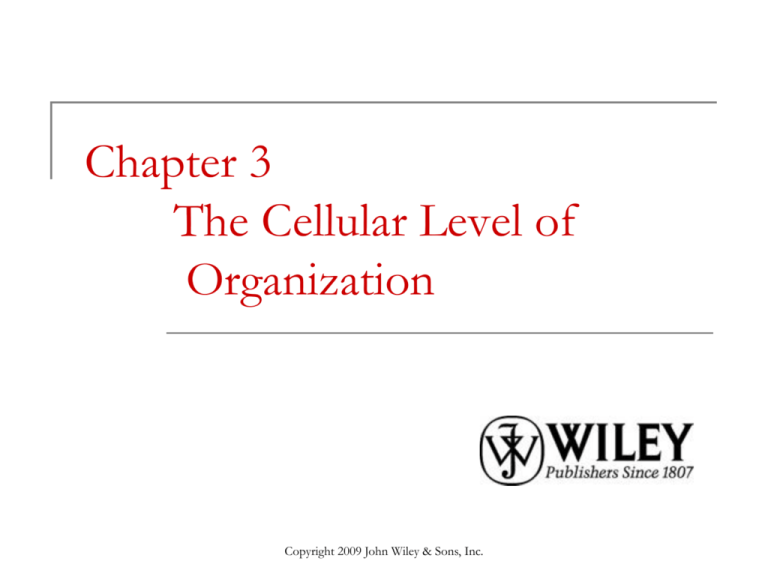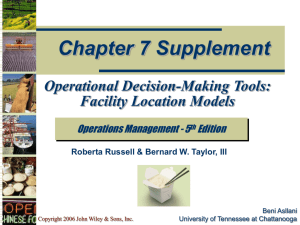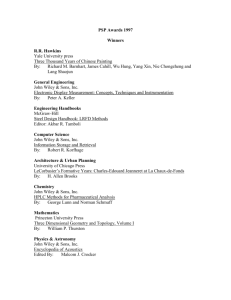
Chapter 3
The Cellular Level of
Organization
Copyright 2009 John Wiley & Sons, Inc.
A Generalized Cell
1. Plasma membrane
- forms the cell’s outer boundary
- separates the cell’s internal environment
from the outside environment
- is a selective barrier
- plays a role in cellular communication
Copyright 2009 John Wiley & Sons, Inc.
A Generalized Cell
2. Cytoplasm
- all the cellular contents between the plasma
membrane and the nucleus
- cytosol - the fluid portion, mostly water
- organelles - subcellular structures having
characteristic shapes and specific functions
Copyright 2009 John Wiley & Sons, Inc.
A Generalized Cell
3. Nucleus
- large organelle that contains DNA
- contains chromosomes, each of which
consists of a single molecule of DNA and
associated proteins
- a chromosome contains thousands of
hereditary units called genes
Copyright 2009 John Wiley & Sons, Inc.
Fig. 3.1 Generalized Body Cell
Plasma Membrane
Flexible yet sturdy barrier
The fluid mosaic model - the arrangement of
molecules within the membrane resembles a
sea of lipids containing many types of
proteins
The lipids act as a barrier to certain
substances
The proteins act as “gatekeepers” to certain
molecules and ions
Copyright 2009 John Wiley & Sons, Inc.
Structure of a Membrane
Consists of a lipid bilayer - made up of
phospholipids, cholesterol and glycolipids
Integral proteins - extend into or through the
lipid bilayer
Transmembrane proteins - most integral
proteins, span the entire lipid bilayer
Peripheral proteins - attached to the inner
or outer surface of the membrane, do not
extend through it
Copyright 2009 John Wiley & Sons, Inc.
Structure of the Plasma Membrane
Copyright 2009 John Wiley & Sons, Inc.
Structure of a Membrane
Glycoproteins - membrane proteins with a
carbohydrate group attached that protrudes
into the extracellular fluid
Glycocalyx - the “sugary coating”
surrounding the membrane made up of the
carbohydrate portions of the glycolipids and
glycoproteins
Copyright 2009 John Wiley & Sons, Inc.
Functions of Membrane Proteins
Some integral proteins are ion channels
Transporters - selectively move substances
through the membrane
Receptors - for cellular recognition; a ligand
is a molecule that binds with a receptor
Enzymes - catalyze chemical reactions
Others act as cell-identity markers
Copyright 2009 John Wiley & Sons, Inc.
Figure 3.3
Copyright 2009 John Wiley & Sons, Inc.
Copyright 2009 John Wiley & Sons, Inc.
Membrane Permeability
The cell is either permeable or impermeable
to certain substances
The lipid bilayer is permeable to oxygen,
carbon dioxide, water and steroids, but
impermeable to glucose
Transmembrane proteins act as channels
and transporters to assist the entrance of
certain substances, for example, glucose and
ions
Copyright 2009 John Wiley & Sons, Inc.
Passive vs. Active Processes
Passive processes - substances move across
cell membranes without the input of any
energy; use the kinetic energy of individual
molecules or ions
Active processes - a cell uses energy,
primarily from the breakdown of ATP, to
move a substance across the membrane, i.e.,
against a concentration gradient
Copyright 2009 John Wiley & Sons, Inc.
Diffusion
Steepness of
concentration
gradient
Temperature
Mass of diffusing
substance
Surface area
Diffusion
distance
Copyright 2009 John Wiley & Sons, Inc.
Simple Diffusion, Channel-mediated
Facilitated Diffusion, and Carrier-mediated
Facilitated Diffusion
Copyright 2009 John Wiley & Sons, Inc.
Channel-mediated Facilitated Diffusion of
Potassium ions through a Gated K + Channel
Copyright 2009 John Wiley & Sons, Inc.
Carrier-mediated Facilitated Diffusion of
Glucose across a Plasma Membrane
Copyright 2009 John Wiley & Sons, Inc.
Extracellular fluid
Glucose
1
Plasma membrane
Glucose
transporter
Glucose
gradient
2
3
Glucose
Cytosol
Osmosis
1.
2.
Net movement of water through a
selectively permeable membrane from an
area of high concentration of water (lower
concentration of solutes) to one of lower
concentration of water
Water can pass through plasma membrane
in 2 ways:
through lipid bilayer by simple diffusion
through aquaporins, integral membrane
proteins
Copyright 2009 John Wiley & Sons, Inc.
Copyright 2009 John Wiley & Sons, Inc.
Tonicity and its effect on RBCS
Copyright 2009 John Wiley & Sons, Inc.
Active Transport
Solutes are transported across plasma membranes with the use of energy, from an area
of lower concentration to an area of higher Concentration Sodium-potassium pump
Na+
gradient
Extracellular fluid
Na+/K+ ATPase
Cytosol
K+
gradient
3 Na+ expelled
P
3 Na+
1
2K+
ATP
2
ADP
Copyright 2009 John Wiley & Sons, Inc.
3
P
+
4 2K
imported
Transport in Vesicles
Vesicle - a small spherical sac formed by budding off
from a membrane
Endocytosis - materials move into a cell in a vesicle
formed from the plasma membrane
three types: receptor-mediated endocytosis
phagocytosis
bulk-phase endocytosis (pinocytosis)
Exocytosis - vesicles fuse with the plasma
membrane, releasing their contents into the
extracellular fluid
Transcytosis - a combination of endocytosis and
exocytosis
Copyright 2009 John Wiley & Sons, Inc.
Receptor-Mediated Endocytosis
Copyright 2009 John Wiley & Sons, Inc.
1 Binding
Receptor-LDL
complex
Plasma
membrane
LDL particle
Receptor
Invaginated plasma
membrane
Clathrin-coated
pit
2 Vesicle formation
Clathrin-coated
vesicle
3 Uncoating
Transport
vesicle
Uncoated vesicle
4 Fusion with
endosome
5 Recycling
of receptors
to plasma
membrane
Endosome
Transport
vesicle
Digestive
enzymes
Lysosome
6 Degradation
in lysosome
Phagocytosis
Copyright 2009 John Wiley & Sons, Inc.
Bulk-phase Endocytosis
Copyright 2009 John Wiley & Sons, Inc.
Cytoplasm - 2 components
1. Cytosol - intracellular fluid, surrounds the organelles
- the site of many chemical reactions
- energy is usually released by these reactions
- reactions provide the building blocks for cell maintenance,
structure, function and growth
2. Organelles
Specialized structures within the cell
The cytoskeleton - network of protein filaments throughout the
cytosol
-provides structural support for the cell
-three types according to increasing size: microfilaments,
intermediate filaments, and microtubules
Copyright 2009 John Wiley & Sons, Inc.
The Cytoskeleton
Copyright 2009 John Wiley & Sons, Inc.
Organelles
Centrosome - located near the nucleus,
consists of two centrioles and pericentriolar
material (Fig. 2.7)
Cilia - short, hair-like projections from the cell
surface, move fluids along a cell surface
Flagella - longer than cilia, move an entire
cell; only example is the sperm cell’s tail (Fig.
2.8)
Copyright 2009 John Wiley & Sons, Inc.
The Centrosome
Copyright 2009 John Wiley & Sons, Inc.
Cilia and Flagella
Copyright 2009 John Wiley & Sons, Inc.
Organelles
Ribosomes - sites of protein synthesis
Endoplasmic reticulum - network of membranes in
the shape of flattened sacs or tubules
- Rough ER - connected to the nuclear envelope, a
series of flattened sacs, surface is studded with
ribosomes, produces various proteins
-Smooth ER - a network of membrane tubules, does
not have ribosomes, synthesizes fatty acids and
steroids, detoxifies certain drugs
Copyright 2009 John Wiley & Sons, Inc.
Ribosomes
Copyright 2009 John Wiley & Sons, Inc.
Endoplasmic Reticulum
Copyright 2009 John Wiley & Sons, Inc.
Organelles
Golgi complex - consists of 3-20 flattened,
membranous sacs called cisternae
- modify, sort, and package proteins for
transport to different destinations
- proteins are transported by various
vesicles
Lysosomes - vesicles that form from the Golgi
complex, contain powerful digestive enzymes
Copyright 2009 John Wiley & Sons, Inc.
Golgi Complex
Copyright 2009 John Wiley & Sons, Inc.
Processing and Packaging
Copyright 2009 John Wiley & Sons, Inc.
Synthesized
protein
Ribosome
1
Transport vesicle
Entry face cisterna
2
Medial cisterna
3
Exit face cisterna
9
Transport vesicle
(to lysosome)
4
8
Rough ER
6
Transfer vesicle
4
7
5
Transfer vesicle
Secretory
vesicle
Membrane
vesicle
Proteins in vesicle
membrane merge
with plasma
membrane
Proteins exported
from cell by exocytosis
Plasma
membrane
Lysosomes
Copyright 2009 John Wiley & Sons, Inc.
Organelles
Peroxisomes - smaller than lysosomes,
detoxify several toxic substances such as
alcohol, abundant in the liver
Proteasomes - continuously destroy
unneeded, damaged, or faulty proteins, found
in the cytosol and the nucleus
Copyright 2009 John Wiley & Sons, Inc.
Organelles
Mitochondria - the “powerhouses” of the cell
Generate ATP
More prevalent in physiologically active cells: muscles, liver
and kidneys
Inner and outer mitochondrial membranes
Cristae - the series of folds of the inner membrane
Matrix - the large central fluid-filled cavity
Self-replicate during times of increased cellular demand or
before cell division
Copyright 2009 John Wiley & Sons, Inc.
Mitochondria
Copyright 2009 John Wiley & Sons, Inc.
Organelles - Nucleus
Spherical or oval shaped structure
Usually most prominent feature of a cell
Nuclear envelope - a double membrane that
separates the nucleus from the cytoplasm
Nuclear pores - numerous openings in the nuclear
envelope, control movement of substances between
nucleus and cytoplasm
Nucleolus - spherical body that produces ribosomes
Genes - are the cell’s hereditary units, control
activities and structure of the cell
Chromosomes - long molecules of DNA combined
with protein molecules
Copyright 2009 John Wiley & Sons, Inc.
Copyright 2009 John Wiley & Sons, Inc.
Packing of DNA into a Chromosome of a
Dividing Cell
Copyright 2009 John Wiley & Sons, Inc.
Overview of Gene Expression
Copyright 2009 John Wiley & Sons, Inc.
Transcription
Copyright 2009 John Wiley & Sons, Inc.
Translation
Copyright 2009 John Wiley & Sons, Inc.
Large
subunit
P site
Amino acid
Initiator tRNA
tRNA
A site
UAC
GG A U G
C
Small
subunit
P site
Anticodon
2 Large and small ribosomal
subunits join to form a functional
ribosome and initiator tRNA
fits into P site.
Amino acid
(methionine)
A site
UAC
GG A U G
mRNA
Codons
Initiator tRNA
3 Anticodon of incoming tRNA pairs
Anticodon
UAC
GG A U G
with next mRNA codon at A site.
mRNA
Small
subunit
mRNA
binding
site
Start codon
UAC U
GG A U G U A G
1 Initiator tRNA attaches to a
start codon.
New
peptide
bond
4 Amino acid on tRNA at P site
forms a peptide bond with
amino acid at A site.
C
U
G G A U G U GC
mRNA
movement
Stop codon
6 Protein synthesis stops when
the ribosome reaches stop
codon on mRNA.
Key:
= Adenine
5 tRNA at P site leaves ribosome,
ribosome shifts by one codon;
tRNA previously at A site is now
at the P site.
Growing
mRNA
protein
tRNA
= Guanine
= Cytosine
= Uracil
Complete protein
Summary of movement of ribosome along mRNA
Somatic Cell Division - Mitosis
The cell cycle is a sequence of events in
which a body cell duplicates its contents and
divides in two
Human somatic cells contain 23 pairs of
chromosomes (total = 46)
The two chromosomes that make up each
pair are called homologous chromosomes
(homologs)
Somatic cells contain two sets of
chromosomes and are called diploid cells
Copyright 2009 John Wiley & Sons, Inc.
Cell Division
Interphase - the cell is not dividing
- the cell replicates its DNA
- consists of three phases, G1, S, and G2,
replication of DNA occurs in the S phase
Mitotic phase - consists of a nuclear division
(mitosis) and a cytoplasmic division
(cytokinesis) to form two identical cells
Copyright 2009 John Wiley & Sons, Inc.
The Cell Cycle
Copyright 2009 John Wiley & Sons, Inc.
DNA Replication
Copyright 2009 John Wiley & Sons, Inc.
Nuclear Division: Mitosis
Prophase - the chromatin fibers change into
chromosomes
Metaphase - microtubules align the centromeres of
the chromatid pairs at the metaphase plate
Anaphase - the chromatid pairs split at the
centromere and move to opposite poles of the cell;
the chromatids are now called chromosomes
Telophase - two identical nuclei are formed around
the identical sets of chromosomes now in their
chromatin form
Copyright 2009 John Wiley & Sons, Inc.
Cytoplasmic Division: Cytokinesis
Division of a cell’s cytoplasm to form two
identical cells
Usually begins in late anaphase
The plasma membrane constricts at its
middle forming a cleavage furrow
The cell eventually splits into two daughter
cells
Interphase begins when cytokinesis is
complete
Copyright 2009 John Wiley & Sons, Inc.
Centrosome:
Centrioles
Pericentriolar material
1
6
Nucleolus
Nuclear envelope
Chromatin
Plasma membrane
Cytosol
LM all at 700x
(a) INTERPHASE
2
Kinetochore
Centromere
(f) IDENTICAL CELLS IN INTERPHASE
5
Chromosome
(two chromatids
joined at
centromere
Early
Mitotic spindle
(microtubules)
Fragments of
nuclear envelope
Late
(b) PROPHASE
Metaphase plate
3
Cleavage furrow
(c) METAPHASE
4
(e) TELOPHASE
Cleavage
furrow
Chromosome
Early
Late
(d) ANAPHASE
Reproductive Cell Division
During sexual reproduction each new organism is
the result of the union of two gametes (fertilization),
one from each parent
Meiosis - reproductive cell division that occurs in
the gonads (ovaries and testes) that produces
gametes with half the number of chromosomes
Haploid cells - gametes contain a single set of 23
chromosomes
Fertilization restores the diploid number of
chromosomes (46)
Copyright 2009 John Wiley & Sons, Inc.
Reproductive Cell Division
Meiosis occurs in two successive stages:
meiosis I and meiosis II
Each of these two stages has 4 phases:
prophase, metaphase, anaphase, and
telophase
Summary - Meiosis I begins with a diploid cell
and ends with two cells having the haploid
number of chromosomes; in Meiosis II, each
of the two haploid cells divides, the net result
is four haploid gametes that are genetically
different from the original diploid starting cell
Copyright 2009 John Wiley & Sons, Inc.
Copyright 2009 John Wiley & Sons, Inc.
Copyright 2009 John Wiley & Sons, Inc.
Cellular Diversity
The average adult has
nearly 100 trillion cells
There are about 200
different types of cells
Cells come in a variety
of shapes and sizes
Cellular diversity
permits organization of
cells into more complex
tissues and organs
Copyright 2009 John Wiley & Sons, Inc.
End of Chapter 3
Copyright 2009 John Wiley & Sons, Inc.
All rights reserved. Reproduction or translation of this work beyond that
permitted in section 117 of the 1976 United States Copyright Act without
express permission of the copyright owner is unlawful. Request for further
information should be addressed to the Permission Department, John Wiley
& Sons, Inc. The purchaser may make back-up copies for his/her own use
only and not for distribution or resale. The Publishers assumes no
responsibility for errors, omissions, or damages caused by the use of theses
programs or from the use of the information herein.
Copyright 2009 John Wiley & Sons, Inc.







